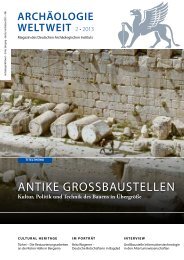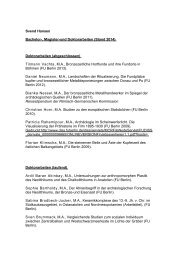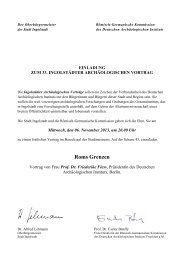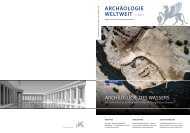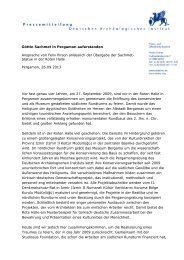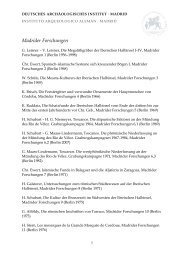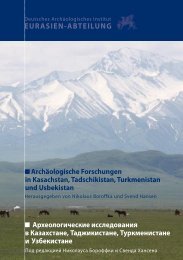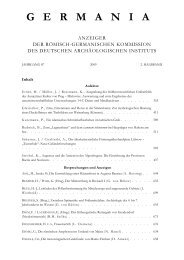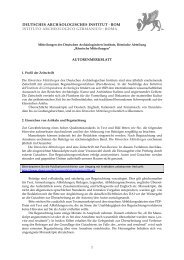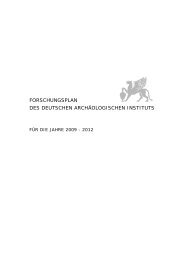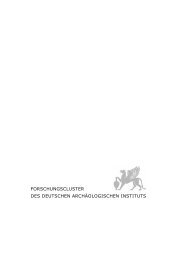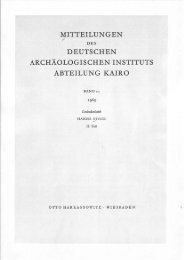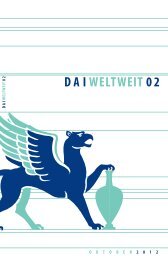german archaeological institute cairo - Deutsches Archäologisches ...
german archaeological institute cairo - Deutsches Archäologisches ...
german archaeological institute cairo - Deutsches Archäologisches ...
Create successful ePaper yourself
Turn your PDF publications into a flip-book with our unique Google optimized e-Paper software.
1<br />
GERMAN<br />
ARCHAEOLOGICAL<br />
INSTITUTE<br />
CAIRO
The Institute<br />
The German Archaeological Institute Cairo is a<br />
department of the German Archaeological Institute<br />
(DAI), a division of the Foreign Offi ce of the<br />
Federal Republic of Germany.<br />
In cooperation with the Egyptian Ministry<br />
of State for Antiquities and other international<br />
partners, the department researches all<br />
Egyptian periods from the prehistoric age to<br />
modern times. The main focus of research is<br />
on settlement and landscape archaeology, the<br />
design and function of ritual spaces, on living<br />
environments and on the reconstruction of cultural<br />
competence and experience. Further key<br />
topics are the relationship between continuity,<br />
transformation, and innovation as well as the<br />
2<br />
perception of ancient Egypt and it‘s role in the<br />
construction of cultural identities, both in Egypt<br />
and in Europe.<br />
The DAI Cairo maintains the second largest<br />
archaeo logical library in Egypt as well as important<br />
archives and its own editorial offi ce. It regularly<br />
organizes conferences and and lectures<br />
that are open to the public. The <strong>institute</strong> also<br />
promotes the qualifi cation of Egyptian scholars<br />
by granting scholarships and running courses<br />
and it encourages contact and exchange between<br />
Egyptian and German researchers within<br />
the frame of its projects and events.<br />
Director: Prof. Dr. Stephan Seidlmayer<br />
Scientifi c Director: Dr. Daniel Polz
History<br />
German research in the fi eld of Egyptian archaeology<br />
was inaugurated by the Royal Prussian<br />
expedition to Egypt and Ethiopia/Sudan<br />
between 1842 and 1845, sent by King Friedrich<br />
Wilhelm IV and headed by Karl Richard Lep sius.<br />
By 1859, the expedition‘s fi ndings had been<br />
published in twelve monumental illustrated volumes,<br />
which made numerous inscriptions and<br />
wall reliefs accessible in excellent quality.<br />
In 1897, the Prussian Academy of Sciences and<br />
Humanities initiated a project directed by Adolf<br />
Erman to create a comprehensive dictionary of<br />
the Ancient Egyptian language. In this context,<br />
the newly born discipline of Egyptology aimed<br />
to establish a research base in Egypt, such as<br />
Germany already had in the Kaiserlich <strong>Deutsches</strong><br />
<strong>Archäologisches</strong> Institut in Rome. Finally,<br />
in 1899, Erman eff ected Ludwig Borchardt‘s<br />
posting as scientifi c attaché to the Consulate<br />
General in Cairo and in 1907 the foundation of<br />
the Kaiserlich <strong>Deutsches</strong> <strong>Archäologisches</strong> Institut<br />
für Ägyptische Altertumskunde. In 1929, this <strong>institute</strong><br />
be came part of the DAI, which already<br />
had departments not only in Rome but also in<br />
Athens and Istanbul.<br />
The department in Cairo was closed in 1939<br />
and parts of its property, including the library,<br />
were confi scated. In 1957, the DAI was able to<br />
re-open its department in Cairo, which then<br />
moved to its current premises in Sharia Abu<br />
el Feda. For the fi rst time, the department received<br />
a budget for <strong>archaeological</strong> excavations<br />
and fi eld studies, which allowed it to support<br />
Opposite:<br />
Since 1957, the DAI Cairo premises are situated at 31,<br />
Sharia Abu el Feda in Cairo-Zamalek, in a 1930‘s villa.<br />
3<br />
Egypt in the documentation and transfer of<br />
Nubian monuments (e. g. the Temple of Amada<br />
and Kalabsha) which were threatened by the<br />
construction of the Aswan Dam. Research projects<br />
were also started at Abu Mina, Elephantine,<br />
Thebes, and Cairo. In the 1970s the <strong>institute</strong><br />
commenced a number of new projects, including<br />
those at Abydos, Cairo, Dahshur, Merimde,<br />
and Saqqara, and in the 1980s, Buto and Maadi.<br />
In 2007 the DAI Cairo celebrated its 100th anniversary<br />
and in 2010 the 200th Karl Richard Lepsius, the founder of German Egyptology<br />
anniversary of<br />
Karl Richard Lepsius‘ birthday.
Current Projects<br />
The research projects of the <strong>institute</strong> cover all<br />
eras of ancient Egyptian culture, from Prehistory<br />
through to the Late Period, as well as the Graeco-<br />
Roman Period, Late Antiquity, and Islamic Period<br />
up to the modern era. In cooperation with the<br />
Ministry of State for Antiquities and interna tional<br />
partners, the <strong>institute</strong> undertakes numerous activities<br />
in Egypt, the most important of which are<br />
named in the following.<br />
• Abu Mina, where the relics of St. Menas were<br />
venerated, was, in terms of surface area, the largest<br />
pilgrimage centre of the ancient world. The<br />
largest churches of the Near East once stood in<br />
this urban site. The crypt church with the relics<br />
of the saint was built in the 6 th century as a tetra-<br />
The large basilica of Abu Mina, the largest church to be excavated in Egypt thus far<br />
4<br />
conch church, an ambitious building type with<br />
apses in all four directions. In addition, the site incorporated<br />
various pilgrim‘s hostels for both the<br />
rich and poor, a religious healing centre work ing<br />
with incubation rites, and baths. All this was located<br />
in the centre of the town, which could be<br />
reached from a northern gate via a 600 m long<br />
colonnaded street.<br />
• Abydos: Predynastic cemetery U and royal<br />
tombs of the 1 st and 2 nd Dynasties (ca. 1300–2700<br />
BCE) at Umm el-Qaab<br />
• AEgArOn (in cooperation with the UCLA): The<br />
project Ancient Egyptian Architecture Online publishes<br />
plans and data of pharaonic buildings on<br />
the Internet. Selected structures from all peri-
Cross-section of the Augustus Temple on Philae, actual<br />
state und reconstruction according to AEgArOn drawing<br />
standards<br />
ods, regions, and areas of life of ancient Egyptian<br />
culture have been re-drawn according to newly<br />
developed standards, both in their actual state<br />
and as reconstructions. All plans can be downloaded<br />
or can be compared and studied in detail<br />
online. The source data is based on publications<br />
and archives, and has been checked against<br />
the orig inal structure wherever possible. The<br />
drawings are supplemented by a critical commentary<br />
nam ing the sources, their authors, inconsistencies,<br />
open questions, etc. The project<br />
addresses the interested public, fellow experts,<br />
and specialists.<br />
• Architectural elements of the Egyptian Late<br />
Period: Technology and development<br />
• Archive of the department: Digitization and<br />
study of the <strong>institute</strong>‘s archive material such as<br />
the academic legacy of Max Meyerhof, Ludwig<br />
Keimer, and Ahmed Fakhry.<br />
• Aswan – Geo<strong>archaeological</strong> survey Gharb Aswan<br />
und Abu al-Rish<br />
5<br />
• Aswan – Historic Islamic necropolis: The<br />
historic Islamic necropolis of Aswan (8 th –12 th<br />
century CE) is the most signifi cant ensemble of<br />
early Islamic tombs in Egypt. Alongside simple<br />
tombs, it is particularly characterised by a large<br />
number of domed mausoleums. The site still<br />
serves as a burial place and a place of worship<br />
of Islamic holy men. Since 2006, the entire site<br />
has been studied and documented in terms of<br />
history, building archaeology and ethnography<br />
in cooperation with the Ministry. In addition, a<br />
concept for the preservation of historical monuments<br />
was devised to protect and preserve the<br />
complex that is being threatened by deterioration<br />
and modern building projects. Since 2009,<br />
individual, heavily damaged mausoleums are<br />
being secured and restored.<br />
• Aswan – Rock inscriptions: The rock land scape<br />
at the fi rst cataract is abundant in inscriptions<br />
from pharaonic times. Outstanding texts give accounts<br />
of military campaigns or the transportation<br />
of enormous monuments. Most of the inscriptions<br />
– several thousands – give the names<br />
and titles of the offi cials who worked in the administration<br />
of the town and temple, in the quar-<br />
Mausoleums of the historic Islamic necropolis in Aswan
Dahshur: Lower causeway leading to the temple, with<br />
the Bent Pyramid in the background<br />
Documentation of a rock inscription near Aswan<br />
6<br />
ries, and the army. They enable a reconstruction<br />
of administrative structures and rit ual activities<br />
in the region. In cooperation with the Ministry<br />
of State for Antiquities, the inscriptions are collected,<br />
deciphered and published in a georeferenced<br />
database. Thus, the preserva tion of the<br />
monuments is ensured. By training the German-<br />
Egyptian team in fi eldwork and analysis, a centre<br />
of excellence for Egyptian epigraphy is being<br />
developed.<br />
• Dahshur: This necropolis is located ca. 30 km<br />
south of Cairo. It is dominated by the stone pyramids<br />
of king Sneferu, the Red Pyramid, and the<br />
Bent Pyramid (4 th Dynasty, ca. 2600 BCE), which<br />
are situated in the desert. The mud brick pyramids<br />
of the Middle Kingdom (12 th Dynasty, ca.<br />
1900–1800 BCE) were built closer to the fl oodplain.<br />
The DAI Cairo has been working at Dah-
shur since 1975 and examined the pyramid<br />
complexes of Amenemhat III, the Red Pyramid,<br />
and the Bent Pyramid. Furthermore, comprehensive<br />
research on the cemeteries of the high<br />
offi cials and priests was conducted. Current<br />
work focuses on the study of the valley tem ples,<br />
causeways, pyramid towns, and workmen’s settlements.<br />
A landscape-archaeology project is<br />
collecting data for reconstructing the ancient<br />
landscape and environment (funding: German<br />
Research Founda tion, excellence cluster TOPOI,<br />
Berlin. Cooperation with the FU Berlin).<br />
• Dra’ Abu el-Naga, Western Thebes: Since 1991<br />
the necropolis of Dra’ Abu el-Naga has been <strong>archaeological</strong>ly<br />
investigated. Its fi nds and features<br />
cover a period from the 2 nd millennium<br />
BCE to the 8 th century CE. The social spectrum<br />
comprises royal and elite tombs as well as modest<br />
mat burials. The collected data sheds light<br />
on the change of tomb architecture, funerary<br />
equipment, and ritual practice, and thus reveals<br />
the development of a necropolis. A research focus<br />
lies on exploring the tombs of the Second In-<br />
Dra‘ Abu el-Naga: Mud brick pyramid of king Nubkheperre-Intef<br />
7<br />
Participants of the ‚International Winter School: Texts<br />
and their Landscape. Papyrology and Archaeology in<br />
the Fayum‘ 2011 on excursion to Dimai.<br />
termediate Period (ca. 1800–1550 BCE). The mud<br />
brick pyramid of king Nubkheperre-Intef of the<br />
17 th Dynasty, discovered in 2001, has been restored<br />
and partly reconstructed. The site will be<br />
made accessible for visitors once the <strong>archaeological</strong><br />
research is completed.<br />
• Early copper metallurgy in Sinai and the<br />
copper supply of Predynastic Egypt<br />
• Elephantine: Border-town and trading post on<br />
the southern border of Egypt (German-Swiss cooperation)<br />
• Fayum Survey Project – The Themistou Meris:<br />
An <strong>archaeological</strong> survey in the north-western<br />
part of the Fayum Oasis<br />
• History of the DAI Cairo within the context of<br />
German political interests from 1881 to 1966<br />
• Industrial architecture in Egypt in the 19th and 20th centuries: Starting in 2009, the survey<br />
project addresses an important and hitherto
“Castle-style” along the Nile: Cotton ginning mill near Qanatir al-Khayriyya (built 1895)<br />
neglected part of Egypt’s architectural heritage.<br />
Historical industrial buildings throughout Egypt<br />
are being studied through site visits and photographic<br />
documentation, by collecting informa<br />
tion about their construction history, builders,<br />
and companies, by architectural surveys of selected<br />
buildings, and the evaluation of archive<br />
material. The project aims at tracing the development<br />
of Egyptian industrial architecture<br />
within a local and global context. It examines<br />
ques tions concerning building typologies,<br />
build ing techniques, and the transfer of technologies,<br />
and thereby studies the role of important<br />
protag onists (architects, engineers, companies).<br />
8<br />
• Maadi: Settlement of the 4 th millennium BCE<br />
on the southern outskirts of Cairo<br />
• Michigan-Papyri: A collection of Greek papyri<br />
in the Egyptian Museum is being restored, catalogued,<br />
and transcribed.<br />
• The cult of Osiris at Abydos: Ritual studies at<br />
the mythical burial place of the god Osiris<br />
• Pharan (Sinai): Early Christian episcopal city<br />
which was fortifi ed and included several churches<br />
• Regional survey Kafr esh-Sheikh: Landscape<br />
archaeology and settlement networks in the<br />
northern central Delta of the Nile.
Excavations at Tell el-Fara’in/Buto<br />
• Residential architecture and culture of the<br />
Cairene upper class between the late 18 th and<br />
the late 19 th centuries<br />
• Saqqara: The tomb of king Ninetjer (2 nd Dynasty,<br />
ca. 2750 BCE) and its later phases of use<br />
• Siwa – The Temple of the Oracle: Examination<br />
and structural reinforcement of the monument<br />
complex of Aghurmi und Umm Ubayda<br />
• Tell el-Fara’in/Buto: The settlement mound<br />
of Buto (Tell el-Fara’in) allows the tracing of cultural,<br />
socio-economic, and political processes<br />
in Egypt from the early 4 th millennium until the<br />
Old Kingdom. The excavations revealed not only<br />
Buto’s earliest occupation – a village of the Lower<br />
Egyptian Maadi culture based on agriculture<br />
and fi shing – but also the increasing infl uence<br />
of the Upper Egyptian Naqada culture during<br />
the second half of the 4 th millennium that fi nally<br />
led to the coalescence of both cultures and the<br />
Kôm el-Hetan: The northern colossus and fragments of<br />
its socle were re-erected in its original position in front of<br />
the temple‘s second pylon in 2012<br />
9<br />
emergence of the early Egyptian state. The development<br />
of administrative structures and control<br />
during the 1 st and 2 nd Dynasties is refl ected by a<br />
large palace-like building, which seems to have<br />
served the organization of the region’s agricultural<br />
production.<br />
• Wadi Sura: A prehistoric rock art station and its<br />
land scape context in the Gilf Kebir<br />
• Western Thebes: Tombs of offi cials, Coptic<br />
monastery Deir el-Bachit<br />
• Western Thebes, Kôm el-Hetan: Excavation<br />
and conservation of the mortuary temple of<br />
Amenhotep III (18 th Dynasty, ca. 1350 BCE)
Facilities<br />
Library<br />
The core of the <strong>institute</strong>‘s library is the collection<br />
of the Egyptologist Ludwig Keimer (1892–1957),<br />
which was bought for the re-opening of the <strong>institute</strong><br />
in 1957.<br />
The library currently comprises approximately<br />
33 000 titles in nearly 42 000 volumes and subscribes<br />
to ca. 300 journals and series. The focus<br />
of the collec tion lies on the material and written<br />
culture of Egypt from prehistoric until modern<br />
times, and is supplemented by literature on<br />
neighbouring regions. The highlight of the library<br />
is a magnifi cent collection of early travel<br />
literature.<br />
The library is accessible to scholars as well as<br />
students. They are requested to give prior notifi<br />
cation of their visit, e. g. by email. The books are<br />
ordered by subject groups and can be accessed<br />
freely by hand, but cannot be lent out. Copies<br />
can only be made in exceptional cases (a charge<br />
will be made).<br />
ZENON, the DAI‘s central online catalogue includes<br />
the complete collection of the Cairo library<br />
and is accessible via http://opac.dainst.org.<br />
OPENING HOURS:<br />
Sunday: 9.00 am–4.00 pm<br />
Monday to Thursday: 9.00 am–1.00 pm<br />
www.dainst.org/department/bibliothek-kairo<br />
bibliothek@kairo.dainst.org<br />
10<br />
Archive<br />
The archive of the Cairo department mainly<br />
comprises the academic legacy of Ludwig Keimer,<br />
which includes a part of the records of his<br />
friend Max Meyerhof (1874–1945).<br />
Further scientifi c archive material along with former<br />
fi les of the <strong>institute</strong> itself (in so far as it is not<br />
kept at the DAI headquarters in Berlin) are currently<br />
being digitized.<br />
The archive is open to academic users by prior<br />
arrangement.<br />
bibliothek@kairo.dainst.org<br />
The department owns a splendid collection of early<br />
travel literature
Photo Archive<br />
The photo archive of the DAI Cairo is focused<br />
on the documentation of the department’s research<br />
since its re-opening in 1957.<br />
Historical glass plate photograph of the island of Philae<br />
There are approximately 240 000 photographs<br />
in diff erent formats as well as digital pictures.<br />
The archive also includes approximately 10 000<br />
pictures taken in Egyptian museums and magazines.<br />
In addition, the department owns approximately<br />
6 000 glass plates and large format pictures.<br />
Primarily, this archive is used for publications on<br />
the <strong>institute</strong>‘s own projects and for those published<br />
by the Cairo department. Beyond this, the<br />
<strong>institute</strong> is happy to support colleagues in their<br />
research for other publications when ever possible.<br />
fotothek@kairo.dainst.org<br />
11<br />
Editorial Offi ce<br />
One of the central tasks of the DAI Cairo is the<br />
high-quality publication of research results. This<br />
is carried out in various formats; the languages<br />
of publication are German, English, and French.<br />
Since 1930, the annual Mitteilungen des DAI Kairo<br />
off er an international platform for contributions<br />
on the archaeology and cultural history of Egypt.<br />
Reports on the <strong>institute</strong>‘s ongoing research projects<br />
are regularly published here, but the journal<br />
also welcomes external contributions. The<br />
quality of all articles is ensured by a peer review<br />
procedure.<br />
The DAIK monographic series publish important<br />
works on the archaeology and history of Egypt.<br />
Since 1958, three sub-series of monographs on<br />
Egyptian, Coptic, and Islamic Studies are published<br />
in the Abhandlungen of the DAI Cairo. The<br />
series Archäologische Veröff entlichungen, which<br />
was started in 1970, focuses on the <strong>archaeological</strong><br />
work of the department. The series Sonderschriften<br />
des DAIK was founded in 1975. Since<br />
1990, the journal Studien zur Archäologie und<br />
Geschichte Altägyptens is published in cooperation<br />
with the Institute of Egyptology of the Uni<br />
versity of Heidelberg. In 2012, the fi rst volume<br />
of the new series Menschen – Reisen – Forschungen<br />
was issued, which focuses on the history of<br />
Egyptology and early travellers.<br />
Since 1957, approximately 250 volumes have<br />
been published.<br />
redaktion@kairo.dainst.org
31, Abu el-Feda<br />
26 th July<br />
Muhammad Mazhar<br />
Brazil<br />
German Archaeological Institute Cairo<br />
31, Sh. Abu el-Feda,<br />
11211 Cairo Zamalek, Egypt<br />
Phone: +20-2-27 35-14 60, -23 21<br />
Fax: +20-2-27 37 07 70<br />
e-mail: sekretariat@kairo.dainst.org<br />
N<br />
12<br />
In order to undertake its work, the German Archaeological<br />
Institute in Cairo depends on support<br />
from third parties and donations. It is extremely<br />
grateful to funding institutions and to<br />
private sponsors for their help.<br />
We would particularly like to mention the following:<br />
The German Research Foundation (DFG); the<br />
German Academic Exchange Service (DAAD);<br />
the Society of Friends of the German Archaeological<br />
Institute, Theodor-Wiegand-Gesellschaft<br />
e.V.; the Gerda-Henkel-Foundation, the<br />
Thyssen-Foundation as well as numerous private<br />
donators.<br />
You too can support the work of DAI Cairo with<br />
your donations:<br />
Payee: Bundeskasse Halle<br />
Bank: Deutsche Bundesbank, Filiale Leipzig<br />
IBAN: DE38 8600 000 000 8600 10 40<br />
BIC: MARKDEF 1860<br />
Reference: ZV91890136 Kairo + Project Name<br />
www.dainst.org/department/kairo<br />
Printing: Printness © DAI Kairo, 2012



